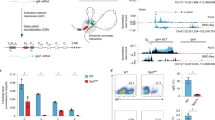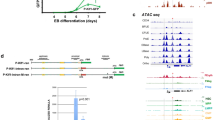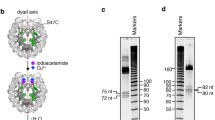Abstract
The octamer sequence ATGCAAAT or its inverse complement ATTTGCAT is well-conserved in all immunoglobulin gene promoters1,2 and has been implicated in promoter function by deletion analysis2–7. Although immunoglobulin promoters are tissue-specific3–6,8, the octamer is also a functional element in non-tissue-specific upstream regions—like those controlling Ul and U2 small nuclear RNA and histone H2B genes—where it is associated with additional canonical elements9–12. Specific interactions occur between the octamer motif and both lymphoid-specific and ubiquitous proteins13–18. By using a synthetic octamer oligonucleotide inserted upstream of the β-globin TATA box we show here that the octamer element by itself is sufficient for directing lymphocyte-specific RNA synthesis when within 70 base pairs of the start site of transcription. We also demonstrate that mutations in any position of the conserved motif interfere with this function.
This is a preview of subscription content, access via your institution
Access options
Subscribe to this journal
Receive 51 print issues and online access
$199.00 per year
only $3.90 per issue
Buy this article
- Purchase on Springer Link
- Instant access to full article PDF
Prices may be subject to local taxes which are calculated during checkout
Similar content being viewed by others
References
Parslow, T. G., Blair, D. L., Murphy, W. J. & Granner, D. K. Proc. natn. Acad. Sci. U.S.A. 81, 2650–2654 (1984).
Falkner, F. G. & Zachau, H. G. Nature 310, 71–74 (1984).
Bergman, Y., Rice, D., Grosschedl, R. & Baltimore, D. Proc. natn. Acad. Sci. U.S.A. 81, 7041–7045 (1984).
Foster, J., Stafford, J. & Queen, C. Nature 315, 423–425 (1985).
Picard, D. & Schaffner, W. EMBO J. 4, 2831–2838 (1985).
Mason, J. O., Williams, G. T. & Neuberger, M. S. Cell 41, 479–487 (1985).
Ballard, D. W. & Bothwell, A. Proc. natn. Acad. Sci. U.S.A. 83, 9626–9630 (1986).
Grosschedl, R. & Baltimore, D. Cell 41, 885–897 (1985).
Murphy, J. T., Burgess, R. R., Dahlberg, J. E. & Lund, E. Cell 29, 265–274 (1982).
Mattaj, I. W., Lienhard, S., Jiricny, J. & De Robertis, E. M. Nature 316, 163–167 (1985).
Ciliberto, G., Buckland, R., Cortese, R. & Philipson, L. EMBO J. 4, 1537–1543 (1985).
Sive, H. L., Heintz, N. & Roeder, R. G. Molec. cell. Biol. 6, 3329–3340 (1986).
Ephrussi, A., Church, G. M., Tonegawa, S. & Gilbert, W. Science 227, 134–140 (1985).
Singh, H., Sen, R., Baltimore, D. & Sharp, P. Nature 319, 154–158 (1986).
Sive, H. L. & Roeder, R. G. Proc. natn. Acad. Sci. U.S.A. 83, 6382–6386 (1986).
Landolfi, N. F., Capra, J. D. & Tucker, P. W. Nature 323, 548–551 (1986).
Staudt, L. M. et al. Nature 323, 640–643 (1986).
Sen, R. & Baltimore, D. Cell 46, 705–716 (1986).
Charnay, P., Mellon, P. & Maniatis, T. Molec. cell. Biol. 5, 1498–1511 (1985).
Berk, A. J. & Sharp, P. A. Cell 12, 721–732 (1977).
Gilman, M., Wilson, R. & Weinberg, R. Molec. cell. Biol. 6, 4305–4316 (1986).
Takahashi, K. et al. Nature 319, 121–126 (1986).
McKnight, S. & Tjian, R. Cell 46, 795–805 (1986).
Gerster, T., Picard, D. & Schaffner, W. Cell 45, 45–52 (1986).
Kelley, D. E. & Perry, R. P. Nucleic Acids Res. 14, 5431–5447 (1986).
Sakano, H., Maki, R., Kurosawa, Y., Roder, W. & Tonegawa, S. Nature 286, 676–683 (1980).
Kataoka, T., Nikaido, T., Miyata, T., Moriwaki, K. & Honjo, T. J. biol Chem. 257, 277–285 (1982).
Serfling, E., Jasin, M. & Schaffner, W. Trends Genet. 1, 224–230 (1985).
Searle, P. F., Stuart, G. W. & Palmiter, R. Molec. cell. Biol 5, 1480–1489 (1985).
Author information
Authors and Affiliations
Rights and permissions
About this article
Cite this article
Wirth, T., Staudt, L. & Baltimore, D. An octamer oligonucleotide upstream of a TATA motif is sufficient for lymphoid-specific promoter activity. Nature 329, 174–178 (1987). https://doi.org/10.1038/329174a0
Received:
Accepted:
Issue Date:
DOI: https://doi.org/10.1038/329174a0
This article is cited by
-
Assembly and analysis of the mouse immunoglobulin kappa gene sequence
Immunogenetics (2004)
-
B cell development and immunoglobulin gene transcription in the absence of Oct-2 and OBF-1
Nature Immunology (2001)
-
B-cell-specif ic coactivator OBF-1/OCA-B/Bob1 required for immune response and germinal centre formation
Nature (1996)
-
Direct evidence that the POU family transcription factor Oct-2 represses the cellular tyrosine hydroxylase gene in neuronal cells
Journal of Molecular Neuroscience (1995)
-
The inhibitory domain in the Oct-2 transcription factor represses gene activity in a cell type-specific and promoter-independent manner
Molecular Biology Reports (1995)
Comments
By submitting a comment you agree to abide by our Terms and Community Guidelines. If you find something abusive or that does not comply with our terms or guidelines please flag it as inappropriate.



